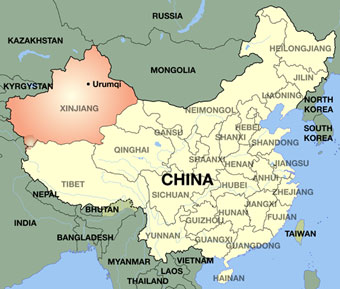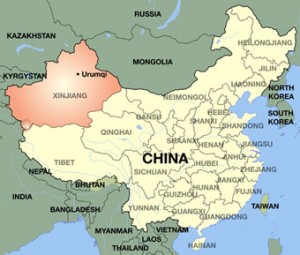Despite the intense efforts of Beijing to Sinicise Xinjiang, it remains the most un-Chinese of China’s administrative regions and the only one with a majority Muslim population. It occupies one-sixth of China’s territory featuring the largest desert in the world, the highest mountains in Asia after the Himalayas, and one of the most ethnically diverse regions on the Eurasian land-mass.
When Chinese dynasties were potent Hsu Yu (Western Region) was fortified with military encampments. This was generally the case respectively during the Han, Tang, Yuan, Ming and Ch’ing Dynasties. (1) But the many walls built and reinforced by the aforementioned dynasties did not extend beyond the Jade Gate of Yumenguan at the desert’s edge. (2) However, during weak periods, the organs of centralized administration gave way to the sway of local potentates and Xinjiang became prey to imperial Russian, British, Japanese, and even Persian imperial rivalries, often pejoratively referred to as “The Great Game.” (3)
Presently, the powerful centripetal torque of the Chinese Communist Party keeps Xinjiang within China’s orbit, for the time being. The implosion of the Soviet Union provided the Peoples’ Republic of China (PRC) with an unprecedented historic opportunity to integrate and perhaps assimilate the ethnic groups of Xinjiang into the Chinese “family of peoples.” (4) It also tempted Beijing to strive for regional hegemony over the post-Soviet Central Asian Republics. No longer is Xinjiang an isolated dominion or pawn of imperial rivals. Xinjiang is China’s port of entry to Kazakhstan, Kyrgyzstan, Uzbekistan, and Tajikistan. Indeed China has invested heavily in these newly independent states and has eclipsed Putin’s Russia in political and military influence throughout the region as well. (5)
Nevertheless, there are powerful countervailing centrifugal forces that are currently challenging China’s newly attained high-profile regional role. The most resilient resistance to Chinese hegemony is the resurgent influence of “Political Islam” among Xinjiang’s Uighur Muslim population. While terrorism specialists might fancy Beijing’s increased concern over radical Islamist influence in Xinjiang an exotic development, Chinese history includes several chapters covering similar scenarios. (6) Whereas more than a few westerners might be caught up in the “Silk Road” romanticism characterized by Japanese cinematic-journalists, adventure seeking amateur archeologists and new age music buffs, Chinese military and diplomatic strategists are not. China has always feared that even the loss of its most remote outposts would serve as a potential invite to foreign encroachment. This may explain, in part, its aggressive defense of its boundaries with Soviet Russia and India in the 1960s. And it explains its resolute anti-irredentist security posture in Xinjiang today.
The re-kindled embers of Uyghur irredentism radiated throughout Xinjiang, not coincidentally, simultaneous as their Turkic Muslim cousins in the Soviet Central Asian Republics were shaking off the imperial restraints of the rapidly collapsing USSR. The Uyghurs established the Eastern Turkistan Islamic Movement (ETIM) in 1993. (7) Beijing moved quickly to fill the vacuum created by the roll back of Russian control in Central Asia. The opportunity created by the demise of the Soviet Union stimulated an accelerated pace of Sinicization of Xinjiang by the Chinese central government, a tempo that sired increased opposition among the native Muslim minorities of the province. Moreover, Uyghur traditional elites realized that the increased incentives offered Han Chinese to relocate to Xinjiang would soon make them a minority in their own land. China also invested heavily in the newly-independent Central Asian Republics with infrastructure projects: highways, rail, and electrification complexes. However, China’s main focus was on energy extraction oil, natural gas, and coal deposits.
Reconnoitering infiltration routes used by al-Qaeda-trained terrorists from the Islamic Movement of Uzbekistan (IMU) along the Afghan-Uzbek border in the Spring of 2001, I recall discussions I had with Central Asian officials. We discussed China’s low-profile stance on regional terrorism. One prescient Uzbek Ministry of Defense officer opined that Beijing would ultimately be coaxed off the fence by militant Uyghurs returning from terrorist training camps in Afghanistan. Apparently, some U.S.-trained Uzbek Special Forces personnel had intercepted some non-IMU infiltrators, some of whom were Uyghurs. In the following decade, of course, it had become quite common for Uyghurs from Sinkiang to receive training in terrorist camps in Afghanistan or Pakistan.
In the early stages of this contemporary Uyghur resistance to Han imperial rule the political and religious leaders of Xinjiang organized small peaceful protests. However, in early July 2009, a massive demonstration took place in Urumchi. Although reports indicate the protest was peaceful, the crowd’s anger was fanned by Islamist propagandists. Security forces reacted to the disposition of the protestors with violence killing at least 200 demonstrators. (8)
Nonetheless, it was not until 2011 that the maturation of Uighur anti-Han hostility reached a level which could no longer silently suppressed by Chinese authoritarian restrictions. Extremist Uyghurs, with some external assistance from radical Central Asian movements, established terrorist cells in several of Xinjiang’s urban centers, including the capital Urumchi and the fabled Silk Road entrepot of Kashgar. Over the next two years Uyghurs have initiated several mass killings of innocent Han civilians in several of Xinjiang’s towns, as well as having staged other incidents in China Proper. (9) One high profile act included a suicide-bombing operation in Beijing’s Tiananmen Square.
The challenge to China’s sovereignty in Sinkiang is still in its initial stages. Despite the failure of Uyghur separatists to carve out an independent profile for an East Turkestan Republic, their objective to break free of Han Chinese control is not without hope. Beijing is painfully aware that while the odds appear to favor China Proper, this will be a protracted struggle. Beijing is cognizant that this latest contest over Hsu Yu dates back nearly a century and a half when Xinjiang fell prey to Russian and British imperial rivalry in the 1880s.
Chinese leaders realize that despite their regional military and economic supremacy, centrifugal forces may favor the Uyghurs in the long run. The governments of the post-Soviet Central Asian Republics are autocratic with little popular support. The militaries of these states are weak and are primarily employed to keep their populations in line. The bureaucratic administrative structures of these countries are corrupt and inefficient. Moreover, Beijing fears that increased radicalization of the region’s Muslims is fast becoming a potent base of support for Xinjiang Islamists. This is the reason, in large part, why Beijing bans all travel to China by western journalists, human rights officials, and academicians who have been sympathetic to Uyghur political activists and separatists. The Chinese Communist Party sensitive to China’s history of regional warlordism is loathe to expose any challenge to its central control to the outside world.
. . . . . . . . . . . . . . . .
Larry Franklin is a senior fellow at Frontiers of Freedom.
. . . . . . . . . . . . . . . .
Footnotes:
1 The Chronology of Chinese Imperial Dynasties provided by William Theodore de Bary’s Sources of Chinese Tradition: Early Han 221-207 B.C.— Later Han 25-220 A. D.// Tang 618-906//Yuan (Mongol) 1260-1368//Ming 1368-1644// Ch’ing (Manchu) 1644-1912.
2 See any maps of the Great Wall(s) indicating their most westerly terminus.
3 Most books on Central Asia while reference the term “Great Game,” one of which is even titled “The Great Game” by Peter Hopkirk published by Kodansha International Press: Tokyo and New York. 1990.
4 The five major peoples of China are the Han, Manchu, Mongol, Tibetan and the mostly Muslim Hui aka Dungan/Tungan.
5 China’s schedule of bilateral and multilateral military exercises and exchange programs now exceeds Moscow’s own military to military initiatives.
6 Muslims challenged Beijing for control of the southwestern Chinese Province of Yunnan as early as the second decade of the 19th century in what came to be called the Panthay Rebellion. Throughout the first five decades of the 1800s Muslim bandits terrorized Han Chinese towns in Anhui, Henan, and Shandong Provinces which annals refer to as the Nian Rebellion. However, the major rebellion of Muslims against Han Chinese acculturation efforts lasted from 1862-1877. This rebellion was led by the Muslim Warlord Yakub Beg. The wide swath of this rebellion stretched from Xinjiang through Kansu (Gansu), Ningxia, and Shaanxi Provinces.
7 The ETIM aka Turkistan Islamic Party is a terrorist organization with close ties to al-Qaeda. Eastern Turkistan, principally the Chinese Province of Sinkiang/Xinjiang for a brief period in the first two decades of the 20th century enjoyed independence with the collapse of China’s last imperial dynasty, the Ch’ing in 1912.
8 According to Rebiya Kadeer, the President of the World Uyghur Congress over 200 un-armed, peaceful citizens were killed on 5 July 2009.
9 Xinjiang-based Uyghur terrorists have killed Han Chinese in train stations, market places, and targeted Han businesses in Xinjiang for destruction.

